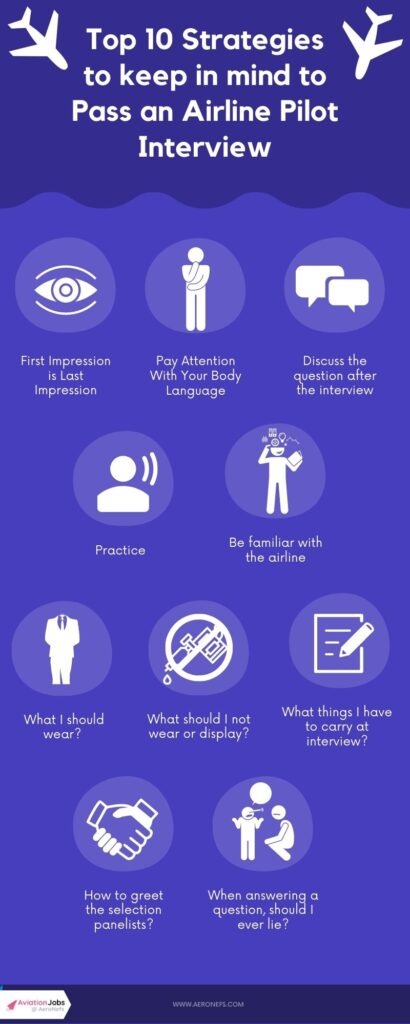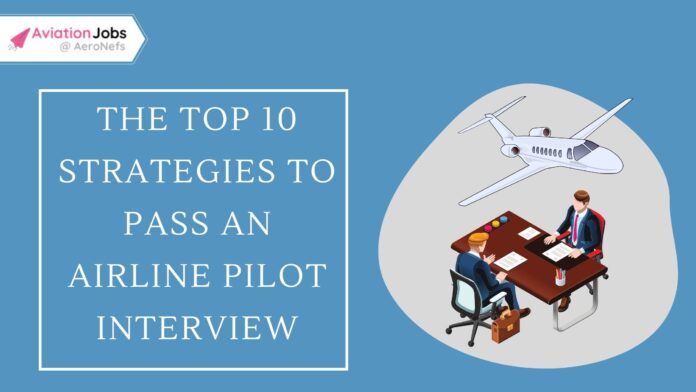- 1. First Impression is Last Impression:
- 2. Pay Attention With Your Body Language:
- 3. In case you have no idea what to answer:
- 4. Practice makes perfect
- 5. Be familiar with the airline
- 6. What should I wear?
- 7. What should I not wear or display?
- 8. What things I have to carry at interview?
- 9. How to greet the selection panelists?
- 10. When answering a question, should I ever lie?
Are you dreaming of becoming a pilot? I am sure you already know how difficult it is to become one. What makes it harder to become a pilot is the interview section. The hardest part of the interview is answering the questions that the interviewer launches. But, no need to worry, we are sharing 10 valuable strategies for passing an airline pilot Interview.
If you are called in for an interview, you’ve already done half the job. Now you need to prove to the recruiters that you are the right person for the position. An airline interview generally consists of two portions: a technical evaluation and a competency assessment.
Many applicants struggle with the competency-based interview because they don’t understand why it is conducted. The majority of airline interviews are now largely a tick box exercise. In simple terms, the assessor will have some boxes that they will have to check to ensure you’ve demonstrated the required competencies – if you check all those boxes you’ll get the job and if not, the assessor won’t be able to process your application further.
So what are the recruiters’ expectations?
You’re expected to demonstrate that you have all the non-technical (soft skills) required to successfully perform the role. Here are the ten most important attributes that you need to demonstrate:
- Flexibility
- Team Work
- Leadership
- Problem Solving
- Motivated/ Passionate
- Empathy
- Prioritisation
- Communication
- Adverse to risk
- Reliability
With all your skills, let’s explore how to pass an airline interview?

1. First Impression is Last Impression:
People form an opinion about you within a few seconds of meeting you. Creating a good first impression will go a long way toward determining how the interview proceeds. You want the recruiter to think that you “look the part” even before the interview begins. To start off on the right foot, wear a plain suit, neutral tie and polished shoes. Carry your documents in a smart briefcase. Make sure that you have neatly trimmed nails, freshly cut hair, and a clean shave.
Greet everyone you encounter throughout the day with a warm smile and a polite greeting. Provide a firm (but not overly firm) handshake if necessary. Everyone should be greeted in the same curious manner, whether it is the receptionist or the CEO. It is possible that any one of these individuals has some input into the recruitment process.
2. Pay Attention With Your Body Language:
Make sure to be receptive and open with your body language. Whenever you are invited to take a seat, sit up straight with your hands on your lap. Don’t cross your arms or lean backwards – this can imply defensiveness or too much relaxation. Be sure to make eye contact with anyone you are speaking to.
When the interviewer keeps asking very similar questions (and asking the same question differently), they’re trying to help! They’re trying to demonstrate the competency that you need to succeed in the interview. Try analyzing which of the above competencies they might be trying to extract from your answer if they ask it in a different way.
3. In case you have no idea what to answer:
A question that you weren’t expecting or didn’t think about will almost always be asked. If you can’t recall an example, ask if you can discuss that question after the interview.
Don’t forget — if you don’t answer the question, the assessor can’t conclude that you demonstrate the required competencies, which means you won’t get the job. If you are still unable to think of an appropriate example, explain what you would do. As a pilot, you must have a certain level of confidence due to the nature of your job. Demonstrate your confidence in your first interactions with people as described above.
4. Practice makes perfect
Make sure you have practised your answers to common interview questions. You don’t have to write down your answers, but you should have an idea of what you want to convey and what examples will demonstrate your qualifications.
Remember that, while you may be attending an interview to be a First Officer, you are in fact being interviewed to become a Captain. When answering interview questions, remember that airlines want to employ future Captains, not career First Officers.
5. Be familiar with the airline
It’s important to be familiar with the airline you are applying for. You should be able to tell the recruiter about the following things:
Aircraft Types (MTOW, VMO, Engines, Passenger Configuration)
2. Airlines biggest competitors
3. Financial and Performance Overview
4. The Industry Threats
5. Destinations
6. What should I wear?
Recruiters look for candidates who are well balanced and don’t possess extreme or unusual characteristics. Avoid standing out negatively during your interview by differing from what is perceived as “normal.” You should convey this through your appearance. An interview is best conducted in a suit and tie. Here are some tips:
- A smart black suit (or similar shades) with the trousers matching the jacket
- Ironed white shirt
- Conservative tie with a Windsor knot (potentially tactfully matching the airlines colour(s)
- Highly polished black shoes
- A black belt to match the colour of the suit
- Cleanly shaved or very neatly trimmed facial hair
- A smart conservative watch
- A conservative hair cut, trimmed within the last few days
- A smart case or folder to carry your documents and licences
7. What should I not wear or display?
- Messy facial and neck hair / stubble
- A suit which is not black or a dark shade of blue/grey
- A brightly coloured or outlandish tie
- Males should remove any piercings
- Cover any visible tattoos
8. What things I have to carry at interview?
In case of a lack of guidance, if you aren’t informed what you need to bring on the day, we recommend that you bring the following items, even if you are not asked to.
- Confirmation of the Interview
- Class One Medical Certificate
- Flying Licence
- Academic qualifications certificates
- Personal, academic and employment references
- Pens and paper pad
9. How to greet the selection panelists?
Introductions should be made with your first name and a firm handshake, and you should make eye contact with the person you are discussing. Smile and greet the person enthusiastically.
10. When answering a question, should I ever lie?
No. You can get caught out if you fabricate an example or lie about your answers. You may end up contradicting yourself later on, or even if they ask you that question again, since you may not remember how you answered. The trained interviewer can sense that your body language and eye movement are changing, which indicates to them that you aren’t telling the truth. If you don’t have an answer, apologize and ask if you can address that question later in the interview.
With these 10 strategies, you’ll be as prepared as any candidate an interviewer has ever seen. Check out AeroNefs today to get started on your new career. Good luck!


